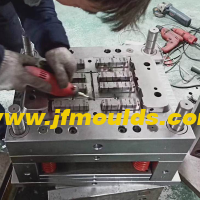Plastic properties and molding conditions
Plastic properties and molding conditions
Different plastics have different properties and molding conditions. For the same type of plastic, if it is produced by different manufacturers, its properties and molding conditions may also vary.
The molding shrinkage rate of plastics
During the molding process of plastic parts, due to the drop in temperature, there is a shrinkage phenomenon where the size decreases. The magnitude of the shrinkage is measured by the shrinkage rate. In the plastic part formula, the shrinkage rate is:
The packaging process of plastic parts, such as the shrinkage of the parts, is divided into two processes: state shrinkage and state shrinkage. Among them, the flow shrinkage is affected by the pressure-holding and feeding effect of the injection molding machine, and has no impact on the size of the plastic part. Solid-state shrinkage is divided into two processes: the shrinkage of the plastic part in the transverse die cavity and the shrinkage of the plastic part after the stock mold. The shrinkage of the plastic part in the mold cavity varies with different dimensions. Now, the dimensions are classified into three types: free shrinkage size, hindered shrinkage size and mixed shrinkage size, as shown in Figure 2-1. Among them, the hindered size L: Due to the obstruction of the shape, it hardly shrinks in the cavity, while the free shrinkage sizes 12, 1 and the mixed shrinkage size L start to shrink after the shape solidifies. The internal shrinkage of the plastic part is the greatest within 1 hour after demolding, and it basically stabilizes after 48 hours, but it takes 30 to 60 days for it to finally stabilize. Contraction after 48 hours is also known as post-contraction.

Automobile bumper mold Manufacturer in China (jfmoulds.com)
There are many factors that affect the dimensional accuracy of plastic parts, among which the most important and difficult to control is the fluctuation of plastic shrinkage rate. tao
The main factors contributing to the fluctuation of plastic shrinkage rate are as follows.
1. Forming pressure. The greater the pressure inside the cavity, the smaller the shrinkage after molding. The shrinkage rates of non-crystalline plastics and crystalline plastics decrease in a straight line and a curve respectively with the increase of internal pressure.
2. Injection temperature. As the temperature rises, the coefficient of expansion of plastics increases, and the shrinkage rate of plastic parts also increases. However, as the temperature rises, the density of the molten material increases, and the shrinkage rate decreases instead. The result of the simultaneous action of the two is generally that the shrinkage rate decreases as the temperature rises.
3. Mold temperature. Generally speaking, the higher the mold temperature, the greater the shrinkage rate of the hindered size L1, and the smaller the shrinkage rates of the free shrinkage sizes L2 and L:. As for the mixed shrinkage size L, it depends on the values of L1 and (L +L3). If L>(L2+L3), its shrinkage rate decreases as the mold temperature rises; otherwise, it increases.
4. Molding time. The longer the holding time during molding and the more sufficient the feeding, the smaller the shrinkage rate will be. At the same time, the freezing orientation of the plastic increases, the internal stress of the plastic part also increases, and the shrinkage rate also increases. The longer the cooling time during molding, the more fully the plastic solidifies and the smaller the shrinkage rate.
Commodity Mould_Taizhou Jiefeng Mould Co.,Ltd. (jfmoulds.com)
5. The structure and wall thickness of the plastic part. Severe asymmetry of the plastic part structure and uneven wall thickness will cause inconsistent shrinkage rates in different parts of the plastic part. In addition, the shrinkage rate of crystalline plastics (except polyoxymethylene) increases with the increase of wall thickness. However, for non-crystalline plastics, the changes in shrinkage rate can be further classified into the following situations: The shrinkage rate of ABS and polycarbonate is not affected by wall thickness; the shrinkage rate of polyethylene, acrylonitrile-styrene, acrylic and other plastics increases with the increase of wall thickness. The shrinkage rate of rigid polyoxymethylene decreases with the increase of wall thickness.
6. Size of the feed inlet. The feeding port is large in size, the plastic part is dense, and the shrinkage is small.
7. Reinforced plastics such as glass fiber. The shrinkage rate decreases with the increase of the filling amount such as glass fiber, but the size remains stable.
Related News
In-depth Analysis of the Injection Mold Industry
2025-07-01
In-depth Analysis of the Injection Mold IndustryI. Overview of the Injection Mol...
Solutions for mold clamping lines, surface clamping marks and clamping position sticking to the mold
2025-08-15
Solutions for mold clamping lines, surface clamping marks and clamping position ...
Design of Injection mold gating system
2025-10-20
Design of Injection mold gating system The injection system of an injection...
The elastic rubber of the mold and the fixed-distance parting mechanism
2025-10-05
The elastic rubber of the mold and the fixed-distance parting mechanismOne: Elas...
Solutions for air streaks, charring, wire jamming, height elevation or trapped air in molds
2025-08-14
Solutions for air streaks, charring, wire jamming, height elevation or trapped a...
Solutions to the problems of hard rubber indentation, row position demolding and inconsistent product dimensions in molds
2025-08-29
Solutions to the problems of hard rubber indentation, row position demolding and...





